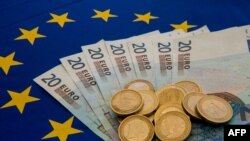The eurozone economic recovery lost momentum in the third quarter of the year, official figures showed Friday — a development that's set to pile further pressure on the European Central Bank to expand its monetary stimulus.
Despite a series of tail winds, the 19-country eurozone grew by only 0.3 percent in the July-September period from the previous quarter. That was below market expectations for a second straight 0.4 percent quarterly rise. On an annual basis, the eurozone economy was 1.6 percent bigger, ahead of the 1.5 percent rate recorded in the second quarter.
The eurozone started recovering from its longest-ever recession a little over two years ago but growth has never managed to get out of a narrow range, despite favorable conditions such as cheaper oil, a lower euro and weak inflation. The slowdown in emerging markets, notably China, isn't helping and is one reason why the ECB is expected to do more in December.
"The subdued pace of growth and persistent weak inflation applies further pressure on the ECB and increases the likelihood of the further measures being announced in December," said Chris Williamson, chief economist at financial information company Markit.
Confidence remains fragile in a region that's spent much of the past seven years dealing with a debt crisis that threatened, at times, the future of the euro currency itself. Unemployment remains at a high 10.8 percent despite modest declines in recent months and governments are still under pressure to rein in spending.
Early indications are that eurozone consumers drove the growth during the third quarter, helping to compensate for subdued industrial and trade activity in many parts of the region.
Growth was muted in many of the eurozone's states during the third quarter.
Germany, the region's powerhouse economy saw its growth dip to 0.3 percent from 0.4 percent. Anemic levels of growth were recorded in Italy and the Netherlands while Portugal saw no growth at all.
And Greece saw its economy shrink again, confounding some predictions that it may have managed to eke out a third consecutive period of growth. The 0.5 percent fall offset the cumulative gains recorded in the previous two quarters and came as the country struggled with stringent controls on money flows imposed by the government, particularly a 60-euro a day limit on ATM withdrawals.
The standout performer once again was Spain, where the economy continues to rebound strongly from recession. Spain's quarterly growth came in at 0.8 percent, meaning the eurozone's fourth-largest economy was 3.4 percent bigger on a year-on-year basis.
France also provided some relief, its economy recording a 0.3 percent expansion after flat-lining in the second quarter.






